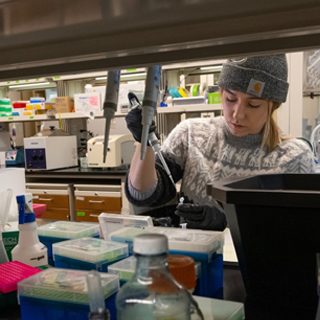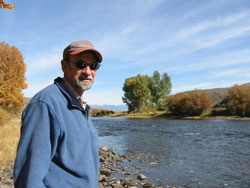CMMB Program Faculty
James Gannon
Professor Emeritus
Contact
- Office
- HS 516A
- Phone
- (406) 243-2471
- Jim.Gannon@umontana.edu
- Curriculum Vitae
- View/Download CV
Education
B.S. University of Houston, 1975
M.S. University of Houston, 1978
Ph.D. University of Houston, 1981
Research Interests
Our primary research efforts fall within the scope of Applied and Environmental Microbiology. Our laboratory focuses on the microbial ecology of industrial processes and process waters, and river systems and their flood plains.
Industrial Microbiology- we working with industry in a number of areas including pulp and paper processing, cooling water, sugar refining, etc. to study how process variables influence the developing microbiota. This information results in better monitoring and control of microorganisms in these systems.
Rivers and Flood Plains:
Contaminated Systems: For the past 8 years we have explored the microbiology of the Clark Fork River flood plain where major flooding events have deposited millions of tons of waste heavy metals. We have focused on understanding microbial processes that govern the movement of heavy metals and how sediment metals have altered the structure and function of the attached microbial communities.
Pristine Systems: We are currently working on two “pristine” river systems. The first is located in the Okavango Delta in Northern Botswana. We are part of an international group studying the effects of the seasonal flooding on the flood plain microbial function relative to the seasonal water cycle. The Okavango Delta is the largest inland delta in the world and one of the last best habitats for wild animals including Lions, Giraffe, Elephants, etc.
A second project is a 5-year NSF Microbial Observatory characterizing the microbial assemblages throughout a large alluvial aquifer that borders Glacier National Park. These studies attempt to define and link microbial assemblage and their nutrient quality to the species- rich abundance of macroinvertebrates. We propose that the nutrient flux and retention mediated by the microbes plays a significant role in driving bioproductivity and biodiversity including charismatic megafauna such as grizzly bear, elk, and bull trout for which the Nyack flood plain is critical habitat.
Selected Publications
K. Feris, Ramsey P., Frazar, C. M. Rillig, J. Gannon, W. Holben. 2004. Hyporheic microbial communities: Determining rates of change and evaluating group-level resiliency differences in response to fluvial heavy metal deposition. Appl. Environ. Microbiol. 2004. 70: 4756-4765
K. Feris, P. Ramsey, C. Frazar, J. Moore, J. Gannon, M. Rillig, and W. Holben. 2004. Seasonal Dynamics of Shallow-Hyporheic-Zone Microbial Community Structure along a Heavy-Metal Contamination Gradient. Appl. Envir. Microbiol. 70: 2323-2331.
K. Feris, P. Ramsey, C. Frazar, J. Moore, J. Gannon, and W. Holben. 2003. Differences in Hyporheic-Zone Microbial Community Structure along a Heavy-Metal Contamination Gradient Appl. Envir. Microbiol. 69: 5563-5573.
K. Feris, Ramsey P., Frazar, C. M. Rillig, J. Gannon, W. Holben. 2003. Seasonal characterization of microbial communities in the hyporheic zone of three streams in western Montana. Microbial Ecology. 46:200-215.
R.M. Callaway, G. Thelen, S. Barth. P. Ramsey and J.E. Gannon (2004). Soil fungi alter interactions between the invader Centaurea maculosa and North American natives. Ecology 85:1062-1071.
Michael J. Gundale, Thomas H. DeLuca, Carl E. Fiedler, Philip W. Ramsey, Mick G. Harrington, and James E. Gannon (2005). Restoration treatments in a Montana Ponderosa Pine Forest: Effects on Soil Physical, Chemical and Biological Properties. Forest Ecology and Management 213: 25-38.
Philip W. Ramsey, Matthias C. Rillig, Johnnie N. Moore, James E. Gannon (2005). Mine waste contamination limits soil respiration rates: a case study using quantile regression. Soil Biology and Biochemistry 37:1177-1183.
Rillig M.C., Lutgen E.R., Ramsey P.W., Klironomos J.N., Gannon J.E. (2005). Microbiota accompanying different arbuscular mycorrhizal fungal isolates influence soil aggregation. Pedobiologia 49:251-259.
Philip W. Ramsey, Matthias C. Rillig, Kevin P. Feris, Nathan S. Gordon, Johnnie N. Moore, William E. Holben, James E. Gannon (2005). Relationship between communities and processes; new insights from a field study of a contaminated ecosystem. Ecology Letters 8: 1201-1210.
Rillig MC, Mummey DL, Ramsey PW, Klironomos JN, Gannon JE. 2006. Phylogeny of arbuscular mycorrhizal fungi predicts community composition of symbiosis-associated bacteria. FEMS Microbiology Ecology 57: 389-395.
Ramsey, P.W., M.R. Rillig, K.P. Feris, W.E. Holben, and J E. Gannon (2006). Choice of methods for soil microbial community analysis: PLFA maximizes power compared to CLPP and PCR-based approaches. Pedobiologia 50:275-280.

